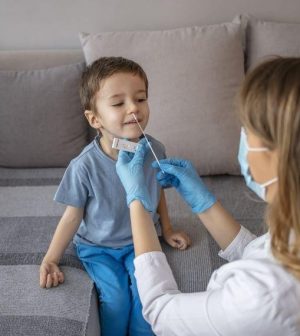- Navigating Your Midlife Crisis: Embracing New Possibilities
- City Raccoons Showing Signs of Domestication
- Mapping the Exposome: Science Broadens Focus to Environmental Disease Triggers
- One Week Less on Social Media Linked to Better Mental Health
- Your Brain Changes in Stages as You Age, Study Finds
- Some Suicide Victims Show No Typical Warning Signs, Study Finds
- ByHeart Formula Faces Lawsuits After Babies Sickened With Botulism
- Switch to Vegan Diet Could Cut Your Greenhouse Gas Emissions in Half
- Regular Bedtime Does Wonders for Blood Pressure
- Dining Alone Could Mean Worse Nutrition for Seniors
Why Were Kids Hit Less Hard by COVID? New Study Offers Clues

Your children’s never-ending colds and sniffles may have protected them from the worst effects of COVID-19, new research suggests.
Throughout the pandemic, it was clear that the SARS-CoV-2 virus tends to cause less severe symptoms in children than in adults, but it wasn’t clear why.
Based on a new analysis of nasal swabs taken during the pandemic, researchers now suspect that the immune system’s inborn response to other viruses and bacteria helped head off severe COVID infection.
“Prior work suggested that heightened nasal innate immunity in children was due to intrinsic biological mechanisms inherent to their age,” said senior study author Ellen Foxman, an associate professor at Yale School of Medicine. “But we thought it could also be due to the high burden of respiratory viruses and bacterial infections in children.”
The innate immune system is the body’s front line of defense against bacteria and viruses.
While the body develops antibodies and more targeted immune responses, the innate immune system kicks into gear. It rapidly churns out anti-viral and pro-inflammatory proteins to fend off infection.
To find out whether frequent respiratory infections boost nasal innate immunity, Foxman’s team re-analyzed more than 600 nasal swabs. The swabs, obtained from kids undergoing surgery or evaluation in the emergency room during the pandemic, initially were tested only for SARS-CoV-2.
For this analysis, researchers looked for 19 respiratory viruses and bacteria. They also measured levels of proteins produced by the innate immune system.
It was no surprise that many kids — including roughly half of those under age 5 — had respiratory infections other than COVID. Those with higher levels of respiratory “bugs” had higher levels of nasal innate immune activity.
Foxman’s team also compared nasal swabs taken from healthy 1-year-olds at a routine well-child checkup and again one to two weeks later.
They found that more than half tested positive for a respiratory virus on one of their two visits, indicating that they had either gotten or cleared an infection during that time.
In almost every case, innate immune activity was higher when kids were infected and lower when they were virus-free, the analysis found.
“This reveals that nasal antiviral defenses are not continually on high alert in young children but are activated in response to acquisition of a respiratory virus, even when that virus is not causing symptoms,” Foxman said.
The findings indicate that the innate immune system is often highly activated because kids are so often infected with relatively harmless respiratory bugs, such as the rhinoviruses that cause the common cold.
Foxman suspects young kids get seasonal viruses more often because they haven’t built up antibodies from prior exposures. Because SARS-CoV-2 was a new virus, no one had prior protection when the pandemic began.
The findings were published July 1 in the Journal of Experimental Medicine.
“In this situation, activation of generalized antiviral defenses in children by other infections may have helped to fight off the initial stages of SARS-CoV-2 infection, leading to less severe outcomes in children compared with adults,” researchers wrote in a journal news release.
Foxman said further study of how seasonal viruses and nasal bacteria affect COVID severity is needed.
More information
The Mayo Clinic has a guide to symptoms, testing and complications of COVID-19 in kids.
SOURCE: Rockefeller University Press, news release, July 1, 2024
Source: HealthDay
Copyright © 2025 HealthDay. All rights reserved.










